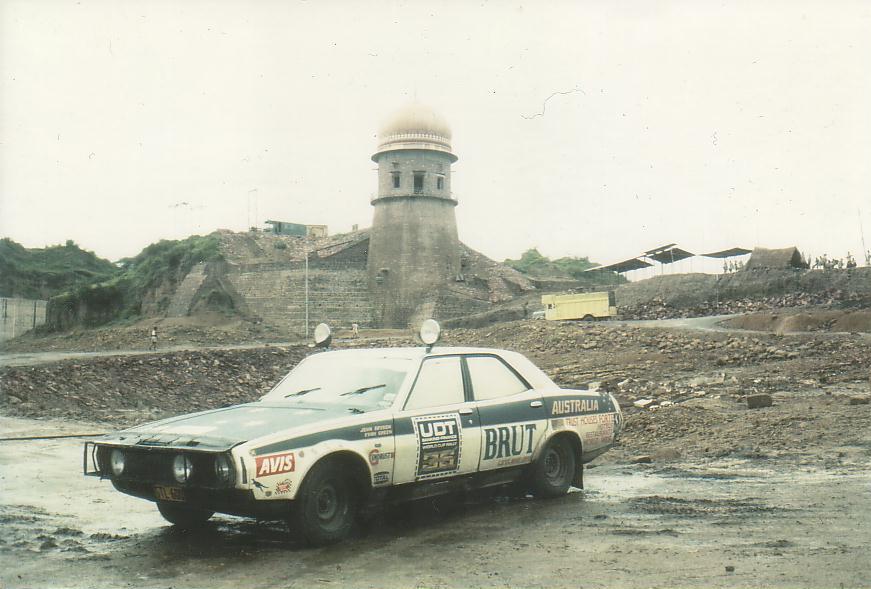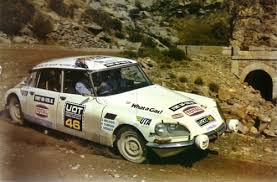by Paul Rogerson
The picturesque Hunter Valley wine region of New South Wales, a two-hour drive north of Sydney, makes for a pleasant weekend escape. But how many enthusiasts are aware that on the outskirts of Maitland there’s a road called Ken Tubman Drive?
Most young people today have never heard of Ken Tubman or know of what he achieved. Seventy-one years ago, Tubman’s Peugeot 203 won the first Redex Trial, but that’s not the story I want to tell today.
From 1952 until he retired in 1983, Tubman ran a pharmacy in High Street, Maitland, but the road was not named in his honour for dispensing prescription medicines. In 1974 Ken Tubman and two other Australians, Jim Reddiex and Andre Welinski, won the London to Munich World Cup Rally in a Citroen DS 23. It was a gruelling event with 70 entrants but only 19 finishers.

One of the other entrants was Evan Green, the Australian motoring journalist, race commentator, public relations person and rally competitor who penned a marvellous book on his adventures on the rally entitled A Boot Full of Right Arms*. Green and his co-driver, John Bryson, drove a Leyland P76, and finished 13th.
The inspiration for long distance rallies that coincided with the hosting of the World Cup was the hugely successful London to Sydney Marathon held in 1968. The first World Cup Rally in 1970 set off from Wembley Stadium, the venue of the final of the previous World Cup in 1966, and ended in Mexico City, the venue for the upcoming tournament. The event attracted over 100 entrants; some factory supported.
The winners of the 1970 World Cup Rally were Hannu Mikkola and Gunnar Palm driving a works Ford Escort. To commemorate the historic victory Ford created a special edition of the Escort called Escort Mexico, today a much sought after model.
The 1974 event was from London to Munich where the final of that year’s World Cup was played. The full title of the event was the ‘London – Sahara – Munich UDT World Cup Rally’. United Dominions Trust, a financier, was the main sponsor and the rally crossed the Sahara Desert not once but twice and travelled through France, Spain, Sicily, Italy, Greece, Turkey, the former Yugoslavia, and Austria before arriving in Munich.
In 1973 the world was in the grip of the first oil crisis so the field of entrants for the 1974 World Cup Rally was drastically reduced as car sales fell and there was less money available for motorsport. There was only one works supported team (Lancia). Nevertheless, world class rally drivers like Andrew Cowan (Ford Escort RS 2000) and Shekhar Mehta (Lancia Fulvia) entered along with former Grand Prix winners, Stirling Moss in a Mercedes-Benz 280E and Innes Ireland in a Jeep Cherokee.
Both Australian entrants were well prepared and crewed by highly experienced rally experts. Evan Green and his navigator, John Bryson, a talented driver who often preferred the navigator’s seat, drove a Leyland P76, sponsored by BRUT 33, a popular men’s aftershave of the time.

The Citroen team of Welinski, Tubman and Reddiex were also highly experienced competitors. Tubman famously won the first Redex Trial in 1953 driving a Peugeot 203, this when the Redex was front page news on most Australian newspapers for two weeks. Andre Welinski had competed in the previous World Cup Rally as well as the 1968 London to Sydney Marathon. Welinski was largely the driving force behind the entry, being the first person to lodge an entry, organise the car and find the largely all French sponsorship. Jim Reddiex had started his working career as an apprentice to a Citroen dealer in Brisbane and became so highly regarded that he supported the works mechanics on the Lucien Bianchi Citroen DS in the London to Sydney Marathon. The Bianchi DS led for much of the way before crashing out near Nowra, just 158kms from the finish. Reddiex was also a handy driver and Citroen dealer.
Of the two entries, the Green/Bryson P76 was the more notable before the Rally began. Green, the motoring editor for the Sun Herald, publicised his entry via his newspaper. The P76 was Leyland’s last great hope of becoming a fourth local manufacturer by finally offering a family sized sedan. The P76, launched in 1973, won that year’s coveted Wheels Car of the Year award so there was much interest in this entry. While the P76 might seem an unlikely rally car today, back then it made perfect sense with its relatively lightweight and 4.4-litre alloy V8. Not to mention the big boot.
Ladbrokes ran a book on the rally entrants and both Australian entries were among the fancied runners at 8 to 1 alongside Stirling Moss and ahead of Innes Ireland at 9 to 1.

The Rally commenced on May 5, setting off from Wembley Stadium, London. The Green/Bryson P76 got off to a poor start breaking down on each of the two special stages to Southampton leaving it in 49th place with the Welinksi/ Tubman/Reddiex Citroen in 36th. The leader, as the cars reached the English Channel, was Sobieslaw Zasada, three-time European rally champion, in a Porsche Carrera.
Racing through France and Spain, Zasada maintained his lead ahead of Cowan in his RS2000 Escort. Green and Bryson had made up a lot of time and were now lying eighth. The other Australian entry was further back.
After crossing by ferry to North Africa, trouble started to afflict most of the field. Not only was the course gruelling, with the Sahara Desert being traversed twice, but there was an error in the navigation notes for part of the Algerian Sahara Desert. New road extensions had been built after the notes were prepared. This caused many of the competitors to become lost. Included among them the Green/Bryson P76 which was leading at the time. Once they had retraced their tracks and found the correct route the rest of field was closing in. Then a front strut snapped leaving them stranded.
Meanwhile back in Australia, coverage of the Rally in the mainstream media was brief to almost non-existent. The small coverage in the sports pages of the tabloid newspapers was often limited to a paragraph or two. All changed when Tubman and co took the lead of the rally and started to put some distance between themselves and the rest of the field. Suddenly, the World Cup Rally was front page news in the tabloids and remained a prominent news item until the Citroen reached Munich to claim victory.
The Citroen crew carried out a recce prior to the rally but became lost when relying upon the official rally notes. Tubman raised the difficulty with the notes with the organisers back in London, but it does not appear that the notes were updated. Even armed with the knowledge of the correct route the Citroen crew still managed to get lost yet moved into the lead by Tamanrasset in southern Algeria. Welinski’s fluent French helped negotiations with border control officials in Africa where many officials spoke French, so much less time was wasted at the border crossings.
The field regrouped in Tamanrasset, the P76 among them. The field set off again with the Australian Citroen now in the lead. More runners dropped out by the time the field reached Tunis for the crossing to Sicily.
Sicily included a special stage around part of the Targa Florio course. The stage was won by Green and Bryson. To commemorate the victory Leyland Australia quickly announced a limited edition P76 known as the Targa Florio which came a with a limited slip differential, sporty wheels and graphics pack with Targa Florio emblazoned on the side of the car. There is no record of Citroen ever releasing a Munich edition of the DS23. Can’t think why.
The Citroen continued to stretch its lead and reached Munich on 25 May, the winning car by more than 28 hours ahead of the next competitor. Welinski, Tubman and Reddiex collected the UDT Trophy and more than £15,000 (circa $30,000) in prize money.

The Australian competitors returned home after the Rally, Green and Bryson choosing to drive the P76 on the London to Sydney Marathon route to get home. Fatefully, Leyland Australia ceased local production shortly after Green and Bryson returned.
Ken Tubman returned to his pharmacy in Maitland where he continued to work until his retirement in 1983. Even in retirement, Tubman helped at his retirement village’s pharmacy.
Ken Tubman died in 1993 but his name lives on with that road just outside of Maitland.
* Much of the research material for this article came from Evan Green’s great book A Boot Full of Right Arms, which forms part of the AMHF’s extensive library on Australian motoring, together with Ken Tubman’s entry in The Australian Dictionary of Biography written by Dr Andrew Moore, one of the volunteers at the AMHF. If you would like to become involved in the AMHF click on the ‘Volunteer’ button at the top of the home page and get involved today.

